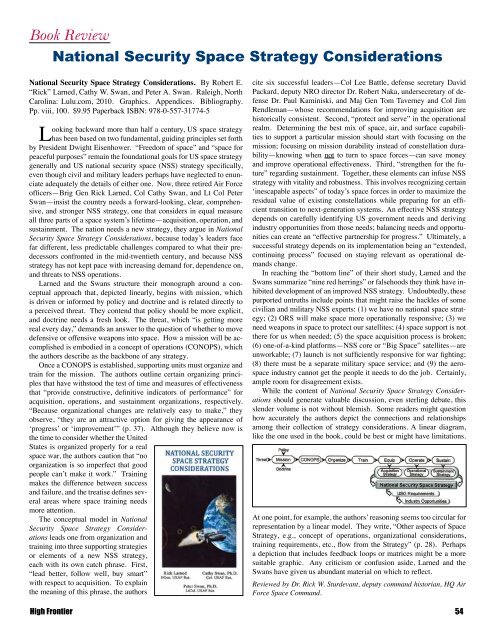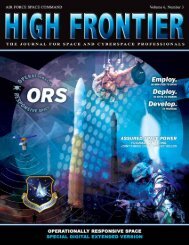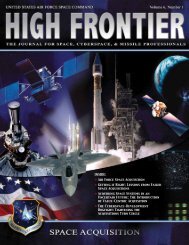Schriever Wargame 2010 - Air Force Space Command
Schriever Wargame 2010 - Air Force Space Command
Schriever Wargame 2010 - Air Force Space Command
- No tags were found...
Create successful ePaper yourself
Turn your PDF publications into a flip-book with our unique Google optimized e-Paper software.
Book Review<br />
National Security <strong>Space</strong> Strategy Considerations<br />
National Security <strong>Space</strong> Strategy Considerations. By Robert E.<br />
“Rick” Larned, Cathy W. Swan, and Peter A. Swan. Raleigh, North<br />
Carolina: Lulu.com, <strong>2010</strong>. Graphics. Appendices. Bibliography.<br />
Pp. viii, 100. $9.95 Paperback ISBN: 978-0-557-31774-5<br />
Looking backward more than half a century, US space strategy<br />
has been based on two fundamental, guiding principles set forth<br />
by President Dwight Eisenhower. “Freedom of space” and “space for<br />
peaceful purposes” remain the foundational goals for US space strategy<br />
generally and US national security space (NSS) strategy specifically,<br />
even though civil and military leaders perhaps have neglected to enunciate<br />
adequately the details of either one. Now, three retired <strong>Air</strong> <strong>Force</strong><br />
officers—Brig Gen Rick Larned, Col Cathy Swan, and Lt Col Peter<br />
Swan—insist the country needs a forward-looking, clear, comprehensive,<br />
and stronger NSS strategy, one that considers in equal measure<br />
all three parts of a space system’s lifetime—acquisition, operation, and<br />
sustainment. The nation needs a new strategy, they argue in National<br />
Security <strong>Space</strong> Strategy Considerations, because today’s leaders face<br />
far different, less predictable challenges compared to what their predecessors<br />
confronted in the mid-twentieth century, and because NSS<br />
strategy has not kept pace with increasing demand for, dependence on,<br />
and threats to NSS operations.<br />
Larned and the Swans structure their monograph around a conceptual<br />
approach that, depicted linearly, begins with mission, which<br />
is driven or informed by policy and doctrine and is related directly to<br />
a perceived threat. They contend that policy should be more explicit,<br />
and doctrine needs a fresh look. The threat, which “is getting more<br />
real every day,” demands an answer to the question of whether to move<br />
defensive or offensive weapons into space. How a mission will be accomplished<br />
is embodied in a concept of operations (CONOPS), which<br />
the authors describe as the backbone of any strategy.<br />
Once a CONOPS is established, supporting units must organize and<br />
train for the mission. The authors outline certain organizing principles<br />
that have withstood the test of time and measures of effectiveness<br />
that “provide constructive, definitive indicators of performance” for<br />
acquisition, operations, and sustainment organizations, respectively.<br />
“Because organizational changes are relatively easy to make,” they<br />
observe, “they are an attractive option for giving the appearance of<br />
‘progress’ or ‘improvement’” (p. 37). Although they believe now is<br />
the time to consider whether the United<br />
States is organized properly for a real<br />
space war, the authors caution that “no<br />
organization is so imperfect that good<br />
people can’t make it work.” Training<br />
makes the difference between success<br />
and failure, and the treatise defines several<br />
areas where space training needs<br />
more attention.<br />
The conceptual model in National<br />
Security <strong>Space</strong> Strategy Considerations<br />
leads one from organization and<br />
training into three supporting strategies<br />
or elements of a new NSS strategy,<br />
each with its own catch phrase. First,<br />
“lead better, follow well, buy smart”<br />
with respect to acquisition. To explain<br />
the meaning of this phrase, the authors<br />
cite six successful leaders—Col Lee Battle, defense secretary David<br />
Packard, deputy NRO director Dr. Robert Naka, undersecretary of defense<br />
Dr. Paul Kaminiski, and Maj Gen Tom Taverney and Col Jim<br />
Rendleman—whose recommendations for improving acquisition are<br />
historically consistent. Second, “protect and serve” in the operational<br />
realm. Determining the best mix of space, air, and surface capabilities<br />
to support a particular mission should start with focusing on the<br />
mission; focusing on mission durability instead of constellation durability—knowing<br />
when not to turn to space forces—can save money<br />
and improve operational effectiveness. Third, “strengthen for the future”<br />
regarding sustainment. Together, these elements can infuse NSS<br />
strategy with vitality and robustness. This involves recognizing certain<br />
‘inescapable aspects” of today’s space forces in order to maximize the<br />
residual value of existing constellations while preparing for an efficient<br />
transition to next-generation systems. An effective NSS strategy<br />
depends on carefully identifying US government needs and deriving<br />
industry opportunities from those needs; balancing needs and opportunities<br />
can create an “effective partnership for progress.” Ultimately, a<br />
successful strategy depends on its implementation being an “extended,<br />
continuing process” focused on staying relevant as operational demands<br />
change.<br />
In reaching the “bottom line” of their short study, Larned and the<br />
Swans summarize “nine red herrings” or falsehoods they think have inhibited<br />
development of an improved NSS strategy. Undoubtedly, these<br />
purported untruths include points that might raise the hackles of some<br />
civilian and military NSS experts: (1) we have no national space strategy;<br />
(2) ORS will make space more operationally responsive; (3) we<br />
need weapons in space to protect our satellites; (4) space support is not<br />
there for us when needed; (5) the space acquisition process is broken;<br />
(6) one-of-a-kind platforms—NSS core or “Big <strong>Space</strong>” satellites—are<br />
unworkable; (7) launch is not sufficiently responsive for war fighting;<br />
(8) there must be a separate military space service; and (9) the aerospace<br />
industry cannot get the people it needs to do the job. Certainly,<br />
ample room for disagreement exists.<br />
While the content of National Security <strong>Space</strong> Strategy Considerations<br />
should generate valuable discussion, even sterling debate, this<br />
slender volume is not without blemish. Some readers might question<br />
how accurately the authors depict the connections and relationships<br />
among their collection of strategy considerations. A linear diagram,<br />
like the one used in the book, could be best or might have limitations.<br />
At one point, for example, the authors’ reasoning seems too circular for<br />
representation by a linear model. They write, “Other aspects of <strong>Space</strong><br />
Strategy, e.g., concept of operations, organizational considerations,<br />
training requirements, etc., flow from the Strategy” (p. 28). Perhaps<br />
a depiction that includes feedback loops or matrices might be a more<br />
suitable graphic. Any criticism or confusion aside, Larned and the<br />
Swans have given us abundant material on which to reflect.<br />
Reviewed by Dr. Rick W. Sturdevant, deputy command historian, HQ <strong>Air</strong><br />
<strong>Force</strong> <strong>Space</strong> <strong>Command</strong>.<br />
High Frontier 54











